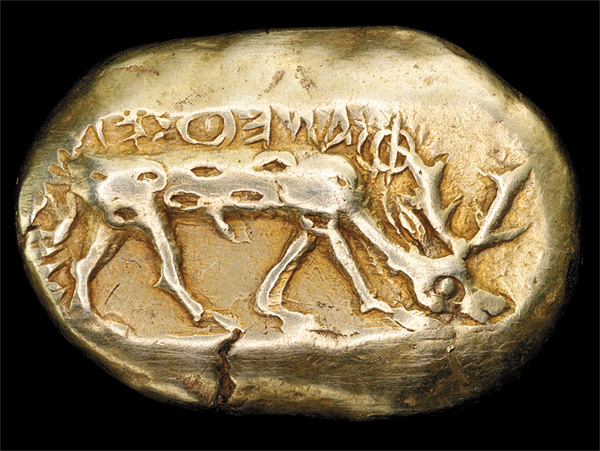Exhibit Watch: Jerusalem of Gold

020
Gold is mentioned 285 times in the Hebrew Bible—more than any other metal—and the use of its imagery by the Biblical writers is as rich and varied as the precious objects into which it was formed throughout antiquity. Gold jewelery offered to Rebecca (Genesis 24) and to Joseph (Genesis 41:39–44) reflect their honored status as Isaac’s bride and Pharaoh’s viceroy, respectively, but the idolatrous golden calf forged at the foot of Mt. Sinai brought shame and suffering on the Israelites. Abraham and Solomon both amassed great riches in gold (Genesis 13; 1 Kings 10)—a sign of God’s favor—yet in Deuteronomy, kings are advised not to seek material fortunes in silver and gold (Deuteronomy 17:17). God tests the faithfulness of his people and refines their hearts like gold (Zechariah 13:9; Malachi 3:3; Job 23:10), yet the Bible mentions several things more valuable than gold: a good name (Proverbs 22:1), wisdom (Job 28) and God’s law (Psalms 119:72).
Although gold is not naturally found in Israel, Jerusalem is aglow with the treasures of two glittering museum exhibits—Pure Gold at the Bible Lands Museum and White Gold at the Israel Museum.
Pure Gold showcases the many desirable qualities of gold—it is rare but accessible, malleable but enduring—in dazzling objects from all over the ancient world. The exhibit is culled predominantly from the Bible Lands Museum’s own collection, which started as the personal collection of the museum’s founder, the late Elie Borowski. Now under the expert guidance of Elie’s wife, director emeritus and cofounder Batya Borowski, and Batya’s daughter, director Amanda Weiss, the museum features one of the world’s finest collections of Biblical artifacts—albeit all unprovenanced objects from the antiquities market.

Gold from the Levant is meager by comparison with that from other areas. The exhibit also features elegant and intricate objects from the Greco-Roman world, Etruria, the Black Sea, Egypt, Mesopotamia, Iran, China and East Asia. All reflect the artistic beauty and technical skill that gold artisans were able to achieve in antiquity.
Just a short walk away, the Israel Museum is offering visitors a unique look at the world’s earliest currency in its White Gold exhibit. The first-ever coins were struck during the late seventh century B.C.E. in the Greek cities of Lydia in western Turkey, where the gold-silver alloy known as white gold, or electrum, occurs naturally. For a time afterward, coins were made only of electrum, and the rarity of the alloy limited the manufacture and use of coins mostly to western Turkey. With the invention of gold and silver coins in the mid-sixth century (also in Lydia), however, the minting and use of coins spread quickly throughout the Mediterranean world.
Coins standardized trade payments and allowed a measurable value to be applied to virtually all goods and services in ancient economies. The governing authorities that minted the coins were able to control the system while expressing their power through the coins’ symbols, also called “types.” In these systems, coins became worth more than the intrinsic value of their metals.
The White Gold exhibit presents 500 examples of electrum coins that were at the forefront of this world-changing development. The coins are divided by depicted types into “Myths,” “Animals” and “Mortals” to highlight the imagery and symbolism presented on these tiny artifacts. The late-seventh-century stater pictured at left depicts a spotted stag below a Greek inscription that reads, “I am the sign of Phanes.”
Through December 31, 2012
Pure Gold at The Bible Lands Museum, Jerusalem
Jerusalem, Israel
www.blmj.orgThrough March 30, 2013
White Gold at The Israel Museum, Jerusalem
Jerusalem, Israel
www.imj.org.il
Gold is mentioned 285 times in the Hebrew Bible—more than any other metal—and the use of its imagery by the Biblical writers is as rich and varied as the precious objects into which it was formed throughout antiquity. Gold jewelery offered to Rebecca (Genesis 24) and to Joseph (Genesis 41:39–44) reflect their honored status as Isaac’s bride and Pharaoh’s viceroy, respectively, but the idolatrous golden calf forged at the foot of Mt. Sinai brought shame and suffering on the Israelites. Abraham and Solomon both amassed great riches in gold (Genesis 13; 1 Kings 10)—a sign of God’s favor—yet in […]
You have already read your free article for this month. Please join the BAS Library or become an All Access member of BAS to gain full access to this article and so much more.
